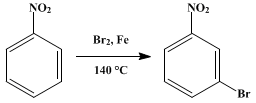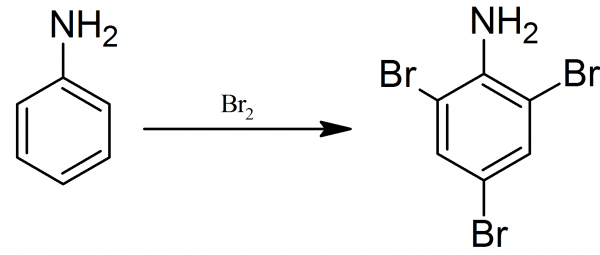When you do aromatic substitutions, you usually see the major products with one substituent added. My question is why can't you add multiple substituents in one reaction? For example, the image below shows nitrobenzene reacting with $\ce{Br2}$ and $\ce{FeBr3}$ to add $\ce{Br}$ to the meta position. Why can't the reaction continue and add to the other meta position and thus make 1,3-Dibromo-5-nitrobenzene?
-
1$\begingroup$ Do we get even this? I have read elsewhere that F-C requires a fairly active ring, and a nitro group could be too deactivating for even one substitution. $\endgroup$– Oscar LanziCommented Mar 22, 2021 at 1:15
-
2$\begingroup$ @Oscar Lanzi: Yes it is possible with $\ce{Fe}$ powder. $\endgroup$– Mathew MahindaratneCommented Mar 22, 2021 at 3:45
2 Answers
The rate of Aromatic substitution depends upon the activity of the aromatic system, because when the collision happens the aromatic system has to donate electrons to an electrophile.
In the example above you have used nitro-benzene, which is very strongly deactivated due to the $\ce{-NO2}$ group and thus the ortho and para positions are completely blocked. The meta position of nitro-benzene is not good but also isn't as bad as the para and ortho positions, in terms of electron density. So, we can say that the meta position of nitro-benzene is just a smidgen less electron rich than normal benzene, and thus first bromination takes place. But, after the addition of one bromine the ring becomes even more electron deficient which just makes further bromination even harder and slower. The reaction slows down to such an extent that it practically ceases to proceed.
On the contrary, if you would use a strongly activated aromatic system like phenol or aniline. It would provide such electron density to the para and ortho positions that they would undergo complete bromination, forming a 2,4,6-tribromo product. The electron density provided by $\ce{-OH}$ and $\ce{-NH2}$ is simply so high that it overcomes the electron deficiency created by the added bromines.
During a electrophilic aromatic substitution, it is always possible to have multiple substitutions during one reaction. However, your example is not the ideal one for a discussion. As noted, Oscar Lanzi has questioned even aromatic ring of nitrobenzene is active enough to give even one $\ce{Br}$ substitution. To clear that, I have found a reliable reference: According to Ref.1, it is possible to brominate nitrobenzene if you have used $\ce{Fe}$ powder in the place of $\ce{FeBr3}$ and at high temperature:
Once brominated, the benzene nucleus is even more deactivated by the newly added $\ce{Br}$ atom than it was with nitro group, which is a strong deactivating group (c.f., the relative rate of reactivity of benzene and chlorobenzene is $1.0$ and $0.033$). This phenomena prevented the additional bromination of the ring even with a stronger catalyst.
One of the best example for the electrophilic aromatic multi-substitution is bromination of phenols and anilines because of the presence of strongly activating groups on the ring such as $\ce{OH}$ in the phenols and $\ce{NH2}$ in the anilines.
Many monohydric phenols react rapidly with bromine in polar solvents such as water to yield solid bromination products, all most all of them are multi-substituted (Ref.2). All the vacant ortho- and para-positions are usually substituted. For example, phenol itself yields an immediate quantitative precipitate of 2,4,6-tribromophenol (Wikipedia):
It is said that controlled partial halogenation of phenols can be effected by using the theoretical amount of halogen dissolved in a less polar solvent such as carbon disulphide and chloroform (Ref.2). However, according to my experience in organic chemistry laboratory, even this reaction gives a significant amounts of minor products with more than one $\ce{Br}$ substitution. The best method to achieve this task is blocking the activating group, in this case, $\ce{OH}$ group. In that way, the blocking group not only significantly deactivate the ring, but also provide enough steric hindrance, which prevent substitution at both ortho-positions.
For instance, the bromination of phenyl acetate would gives you exclusively para-substitution (4-bromophenyl acetate). However, you may need to have a prior arrangement to remove $\ce{HBr}$ formed during the bromination in this case. That's because acetyl protecting group is acid sensitive. For example, the bromination of phenyl acetate have given almost exclusively the para-isomer in quantitative yield, when the reaction is performed in the presence of sodium forms of zeolites X and Y, which have removed $\ce{HBr}$ formed during the reaction by a process of cation exchange (Ref.3).
All of all apply to aniline as well. For example, 2,4,6-tribromoaniline can be prepared by treating bromine water with aniline in a solution of acetic acid or dilute hydrochloric acid (Wikipedia).
Other than halogenation reaction of above types, other example for electrophilic aromatic multi-substitution is Friedel-Crafts alkylation reaction. Once alkylated, the ring would get activated more than it was before the first alkylation (alkyl is activating group). Thus, it would further undergoes second (and/or third) alkylation. Foe comparison, the relative rate of benzene and toluene are $1.0$ and $24.5$. That's the reason, it take long way to mono-alkylate benzene ring by first doing Friedel-Crafts acylation reaction and then reducing carbonyl group to methylene group by an appropriate method.
References:
- John R. Johnson, C. G. Gauerke (Checked by Frank C. Whitmore and T. Otterbacher), "m-Bromonitrobenzene (benzene, 1-bromo-3-nitro-)," Organic Syntheses, Coll. Vol. 1, p.123 (1941); Vol. 8, p.46 (1928)(DOI: 10.15227/orgsyn.008.0046)(PDF).
- P. W. G. Smith, A. R. Tatchell, In Organic Chemistry for General Degree Students, Volume 2: Aromatic Chemistry; Pergamon Press, Ltd: Oxford, United Kingdom, 1969, "Chapter V: Phenols," pp. 79-104 (ISBN-13: 978-0080129471).
- Keith Smith, Ping He, Ashley Taylor, "Selective para-bromination of phenyl acetate. Under the control of zeolites, bases, acetic anhydride or metal acetates in the liquid phase," Green Chem. 1999, 1, 35-38 (DOI: https://doi.org/10.1039/A808242A).



